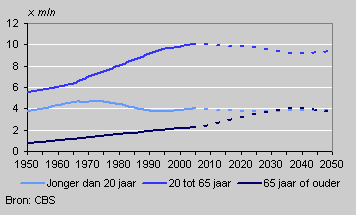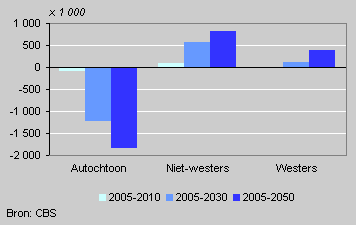Fewer native and more foreign 20-64 year-olds

Statistics Netherlands estimates that the number of 20–64 year-olds in the Netherlands will reach 9.5 million in 2030. This is half a million fewer than in 2005. According to Statistics Netherlands’ recently published population forecasts, the decrease will be the consequence of a substantial drop in the number of native Dutch people and an increase in the number of foreigners in this age group.
Population by age group

More western and non-western foreigners aged 20–64
The age group of 20–64 year-olds is sometimes called the potential workforce. The increase in the number of potential workers among the native Dutch population slowed down at the beginning of the 1990s and started to decrease in 2002. In 2030 it is expected to be 1.2 million lower than in 2005. The number of potential workers with a non-western foreign background will increase, on the other hand: they will number 1.6 million in 2030, nearly 600 thousand more than in 2005. The number of western foreigners in this age group will also increase.
Potential workforce by ethnic background

Growth through migration
The increase in the number 20-64 year-olds with a foreign background is partly caused by the inflow of immigrants and their children and grandchildren. Around 2030 an expected 38 thousand non-western immigrants will arrive in the Netherlands yearly, while just over 20 thousand will leave the country. The number of western immigrants will increase strongly to 57 thousand in 2030. Many western immigrants come for work.
Immigration and emigration by ethnic background

Substantial inflow from European Union
A substantial proportion of western immigrants come from countries in the European Union, including the ten new member states. Statistics Netherlands expects the number of immigrants from the EU to increase from around 23 thousand in 2005, to 35 thousand from 2015. Most of the migrant workers among these 35 thousand will stay in the Netherlands only for a short time. The number of EU citizens who emigrate will rise to 22 thousand in 2015.
Marriage migration plays an important part in non-western immigration. This will contribute to the continuing increase in the Turkish and Moroccan communities in the Netherlands.
Higher labour participation
Obviously, future developments on the labour market will not only be determined by developments in population size and composition. Te higher labour participation of women and older people may also affect the labour market situation.
Jan Latten and Maarten Alders